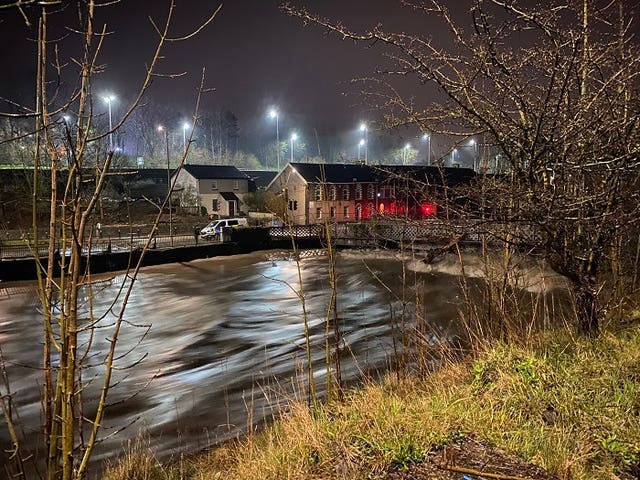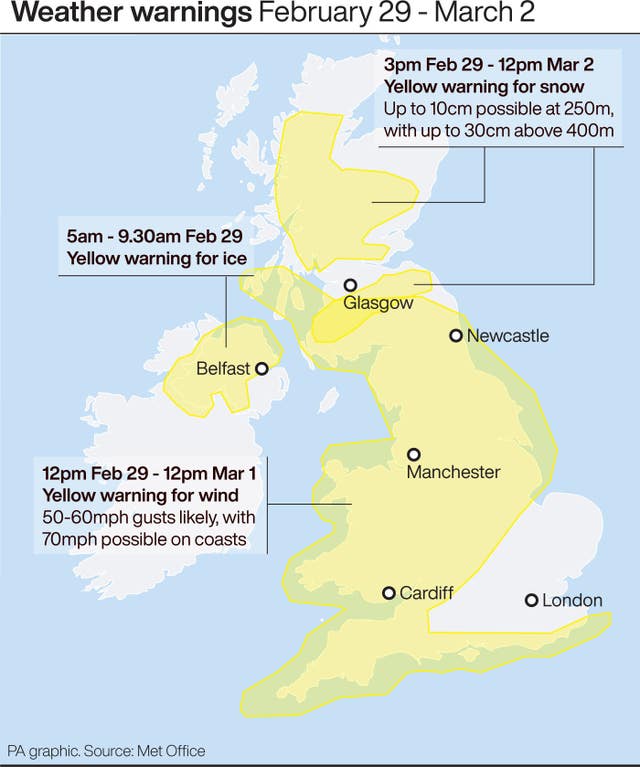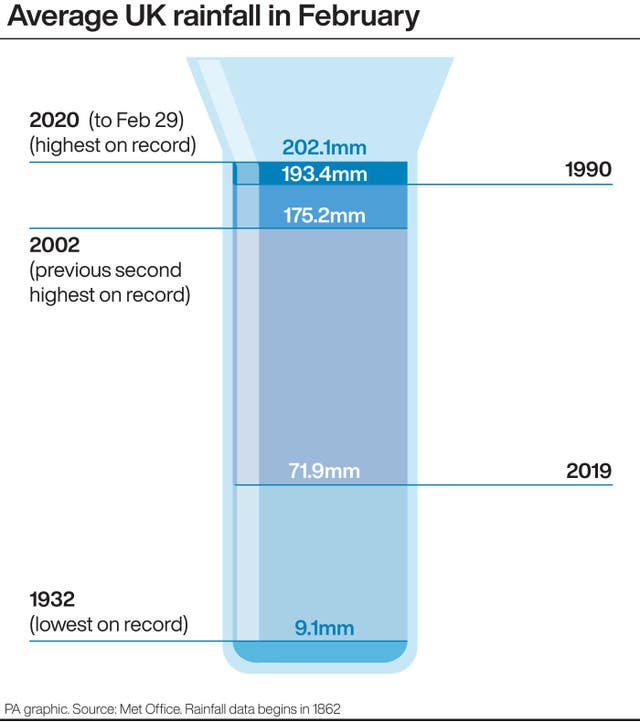
The UK has weathered its wettest February on record after three successive storms brought heavy downpours and flooding.
A UK average of 202.1mm has fallen this month, surpassing February 1990 when 193.4mm fell, the Met Office said.
Some areas were deluged by more than a month’s worth in just 24 hours, as heavy rain which started with Storm Ciara continued with Storm Dennis and now Storm Jorge contributed to record river levels which have seen safety teams put in “Herculean efforts” to erect flood defences to protect homes and businesses.
Jorge, this month’s third named storm, is bringing rain, gales of up to 70mph and snow. It prompted weather warnings stretching from Cornwall to the north of Scotland and across to Northern Ireland.
🚨Breaking news 🚨
Latest rainfall data (up to 9am 29th Feb) reveals that February 2020 is now the wetttest February on record
A UK average of 202.1mm has fallen, beating February 1990 where 193.4mm fell
Full statistics will be released on Monday pic.twitter.com/QLserAKZzA
— Met Office (@metoffice) February 29, 2020
The Environment Agency said 127,000 properties had been protected by flood defences this winter and some 15 rivers in the Midlands, Yorkshire and Lancashire have recorded their highest levels on record.
Several flooded roads were closed in Wiltshire, people were rescued from cars stranded in water in Devon and Somerset, and the Ouse Bridge in Humberside was closed to high-sided vehicles and the speed limit lowered to 40mph amid fears of strong winds.
Police in flood-hit South Wales declared a temporary “critical incident” on Saturday morning as emergency services, councils and other bodies worked to protect property and infrastructure and protect residents.

People in Pontypridd, which was also flooded two weeks ago, and the Ely area of Cardiff were advised to remain indoors amid warnings of further rising water levels and strong winds.
Cardiff Council said emergency teams worked through the night on flood defences, road closures and clearing debris to limit the damage from torrential rains as its roads team answered around 100 incidents.
There were six yellow weather warnings for rain, wind and snow in force across the country on Saturday morning, stretching from Cornwall to the north of Scotland and across to Northern Ireland.

The rain warning was lifted before midday as showers eased but alerts remained in place for gales and the potential for power cuts, transport delays and large waves for coastal communities.
The wind warnings last until 9am on Sunday across much of England and Wales and until 3pm the same day across Northern Ireland, southern Scotland, and northern England.
Persistent snowfall was forecast over higher parts of Scotland, with up to 30cm predicted in some places, with warnings in place until noon on Monday, the Met Office said.
Heavy showers of #rain, #sleet, #snow and #hail in places today 🌧️❄️🌩️
What have you seen?
Here is the latest: pic.twitter.com/YKwTKAtPxN
— Met Office (@metoffice) February 29, 2020
A total of 83 flood warnings were in place across England and Wales, mostly in the South West and along the English-Welsh border, and in Yorkshire, while a further 211 “flooding is possible” alerts are also in force.
The wind-chill factor will make temperatures feel close to freezing, said the Met Office.
Towns including Ironbridge and Bewdley along the River Severn in the West Midlands, and West Cowick and Lidgate in East Yorkshire, along the River Aire, are among the worst-hit areas in England.

The Environment Agency said 1,000 staff per day have worked on flood defences and pumps, clearing debris and repairing damaged defences, erecting 3.7 miles of barriers.
The body warned the country needs to brace itself for “more frequent periods of extreme weather like this” because of climate change.
The leap year does not affect the wettest February record data, the Met Office said.


Comments: Our rules
We want our comments to be a lively and valuable part of our community - a place where readers can debate and engage with the most important local issues. The ability to comment on our stories is a privilege, not a right, however, and that privilege may be withdrawn if it is abused or misused.
Please report any comments that break our rules.
Read the rules here